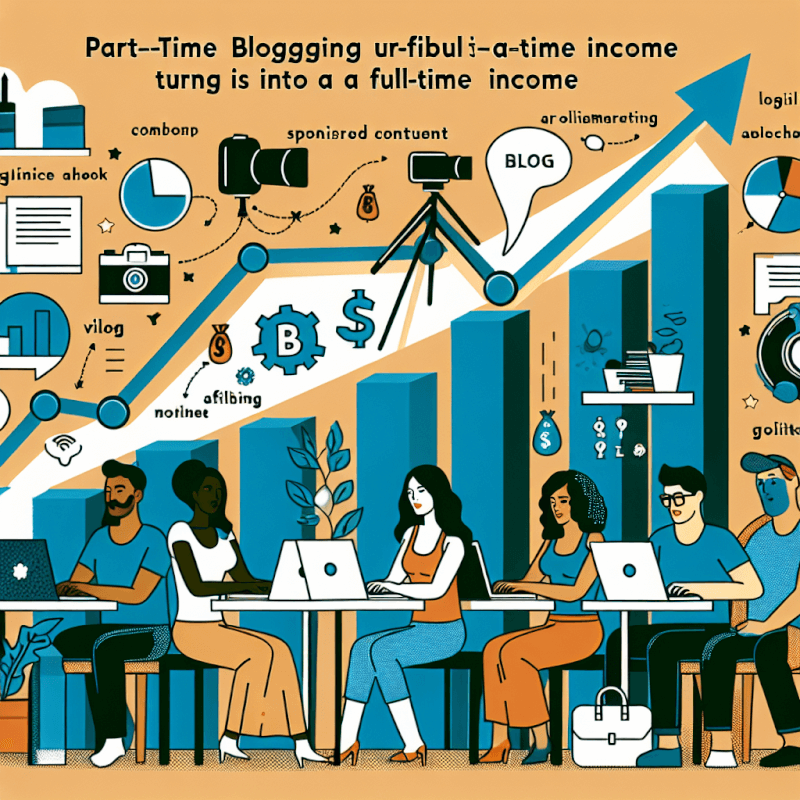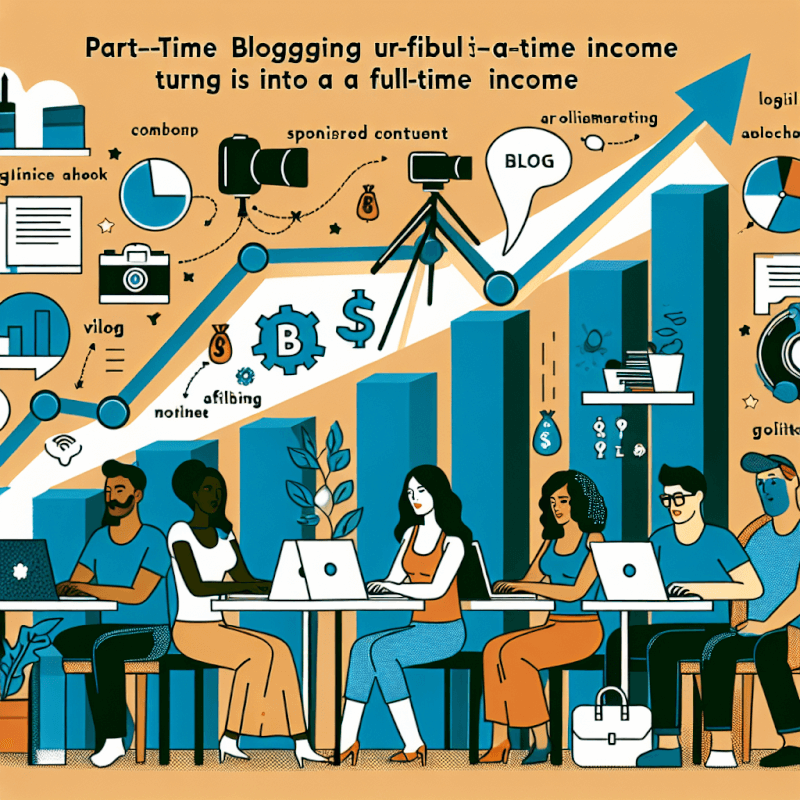Have you ever wondered if it’s possible to make a full-time income from part-time blogging? With the rise of the digital age, more and more people are turning to blogging as a way to earn money and pursue their passions. But can you really make a living from blogging just a few hours a day? In this article, we’ll explore the potential of part-time blogging and uncover the secrets to turning your blog into a profitable business. Get ready to unlock the possibilities of earning a full-time income while working on your own terms.

The Potential of Part-time Blogging
Part-time blogging refers to the practice of running a blog while maintaining another job or pursuing other interests. It offers individuals the opportunity to express their passions, share their knowledge, and potentially earn income. While it may seem daunting to turn a part-time blog into a full-time career, it is certainly possible with the right strategies and commitment.
Defining Part-time Blogging
Part-time blogging involves dedicating a portion of your time, whether it be a few hours a week or a few days a month, to creating and maintaining a blog. It allows you to pursue your passion while still having the stability and security of a regular job or other commitments. By managing your time effectively, you can achieve a balance between your blog and other responsibilities.
Examining the Benefits
Part-time blogging offers numerous benefits that make it an appealing option for individuals looking to make an impact and potentially earn income. Firstly, it provides a creative outlet and allows you to share your ideas and perspectives with an online community. Additionally, it offers the potential for passive income, meaning that you can make money even while you are not actively working on your blog. Finally, part-time blogging can lead to new opportunities such as partnerships, collaborations, and even the chance to turn it into a full-time career.
Exploring Income Possibilities
While it is possible to earn income from part-time blogging, it is important to manage your expectations realistically. The amount of income you can generate will depend on several factors such as the size of your audience, the level of engagement, and the monetization strategies you implement. However, with dedication, consistent effort, and a well-thought-out plan, it is possible to generate a substantial income from your part-time blog. Now that we’ve explored the potential of part-time blogging, let’s dive into the steps you can take to build a successful blog.
Building a Successful Blog
Building a successful blog requires careful planning and execution. By following these steps, you can set yourself up for success and create a blog that stands out among the vast sea of online content.
Choosing a Niche
When starting a blog, it is important to choose a niche that aligns with your interests, knowledge, and target audience’s needs. Find a topic that you are passionate about and that has the potential to attract and engage a specific audience. By focusing on a niche, you can establish yourself as an authority and build a loyal following.
Creating Quality Content
The key to a successful blog is creating high-quality, valuable content that resonates with your audience. Invest time and effort into producing well-researched articles, engaging stories, and helpful tutorials. Focus on providing unique perspectives, actionable advice, and solving problems for your readers. By consistently delivering valuable content, you can build trust, gain credibility, and keep your audience coming back for more.
Building an Engaged Audience
Building an engaged audience is crucial for the success of your blog. Interact with your readers by responding to comments, asking for feedback, and encouraging social media engagement. Foster a sense of community by creating forums or Facebook groups where like-minded individuals can connect and share their thoughts. By nurturing relationships with your audience, you can create a loyal following that will support and promote your blog.
Now that you have a solid foundation for your blog, let’s explore various monetization strategies that can help you turn your part-time blogging into a source of income.
Monetization Strategies for Part-time Bloggers
There are various ways to monetize your blog and generate income. By diversifying your income streams, you can maximize your earning potential. Let’s examine some of the most effective monetization strategies for part-time bloggers.
Advertising and Sponsorships
One of the most common ways to monetize a blog is through advertising and sponsorships. You can display ads on your blog using platforms like Google AdSense or work directly with brands to feature sponsored content. Ensure that any advertisements or sponsorships align with your blog’s niche and values to maintain the trust and interest of your audience.
Affiliate Marketing
Affiliate marketing involves promoting products or services and earning a commission for each sale made through your unique affiliate link. Join affiliate programs that align with your blog’s topic and recommend products or services that you genuinely believe in. Write honest reviews, create tutorials, or offer exclusive discounts to entice your audience to make a purchase through your affiliate links.
Digital Product Sales
Creating and selling digital products like e-books, online courses, or templates can be a lucrative way to monetize your blog. Leverage your expertise and provide valuable resources that your audience can benefit from. Market your digital products through your blog, social media channels, and email newsletters to maximize your sales.
Membership/Subscriptions
Consider offering a membership or subscription plan that provides premium content or exclusive benefits to your audience. This can include access to private forums, advanced tutorials, or personalized coaching sessions. By offering additional value to your most dedicated readers, you can create a reliable stream of income.
Selling Physical Products
If your niche allows for it, selling physical products related to your blog can be another revenue stream. This can include merchandise, handmade goods, or even books. Build an online shop and market your products through your blog and social media to reach your target audience.
Sponsored Content
Similar to advertising and sponsorships, sponsored content involves partnering with brands to create content that promotes their products or services. This can include product reviews, sponsored blog posts, or social media collaborations. Ensure that the sponsored content aligns with your blog’s values and is clearly disclosed to maintain transparency with your audience.
Freelance Writing and Consulting
As an established blogger, you can leverage your expertise and offer freelance writing or consulting services. Write for other publications or offer one-on-one consulting sessions to individuals or businesses looking to benefit from your knowledge. This allows you to capitalize on your expertise while expanding your network and reputation.
Now that you have an understanding of how to monetize your blog, let’s dive into time management and consistency, two crucial aspects of running a successful part-time blog.
Time Management and Consistency
As a part-time blogger, effectively managing your time and maintaining consistency is essential to sustain the growth and success of your blog. Let’s explore some strategies to help you stay organized and focused.
Setting Realistic Expectations
Recognize that as a part-time blogger, you have limited time and resources compared to full-time bloggers. Set realistic expectations for yourself and avoid becoming overwhelmed by trying to do too much too quickly. Understand that building a successful blog takes time and consistent effort.
Creating a Content Schedule
Plan and create a content schedule to ensure a regular flow of posts. Determine how often you can realistically publish new content, whether it be once a week or twice a month, and stick to that schedule. Consistency is key to keep your audience engaged and coming back for more.
Finding a Balance
Maintaining a balance between your blog, other commitments, and personal life is crucial to avoid burnout. Prioritize your tasks, set boundaries, and allocate specific time slots for blogging activities. Remember to take breaks and recharge to maintain your creativity and motivation.
Outsourcing and Delegating Tasks
Consider outsourcing or delegating certain tasks that can free up your time and allow you to focus on creating quality content. This can include hiring virtual assistants for administrative tasks, graphic designers to create visuals, or editors to polish your writing. By delegating responsibilities, you can relieve some of the workload and focus on what you do best.
Now that you have established a solid foundation for your blog and have a plan for managing your time effectively, let’s explore strategies to maximize your blog’s revenue potential.

Maximizing Your Blog’s Revenue Potential
To increase your blog’s revenue potential, it is important to implement various strategies that optimize your monetization efforts. Let’s examine some key strategies to maximize your blog’s revenue potential.
Implementing SEO Strategies
Search Engine Optimization (SEO) is crucial for driving organic traffic to your blog. Conduct keyword research, optimize your blog posts, and focus on creating high-quality content that aligns with search engine algorithms. By ranking higher on search engine result pages, you can attract more visitors and potential customers.
Optimizing Ad Placements
Experiment with different ad placements on your blog to find the most effective positions for generating clicks and conversions. Test different formats, sizes, and locations to determine which placements work best for your audience without compromising the user experience.
Strategic Affiliate Marketing
Continuously evaluate the performance of your affiliate marketing efforts and focus on promoting products or services that yield higher commissions or conversions. Monitor the success of different strategies such as banner ads, text links, or product reviews, and adjust your approach accordingly.
Creating and Marketing Digital Products
Continually create and market new digital products to generate ongoing revenue. Keep your offerings fresh and relevant by conducting market research and understanding the needs and desires of your audience. Promote your digital products through your blog, email newsletters, and social media channels to maximize your sales potential.
Developing a Membership Program
Investigate the possibility of developing a membership program that offers exclusive benefits to your most loyal readers. Continually add value to your membership program by providing new content, personalized services, or discounts. Regularly communicate with your members and solicit feedback to ensure that the program meets their expectations.
Evaluating and Negotiating Sponsored Content Opportunities
When considering sponsored content opportunities, carefully assess the fit with your blog’s niche and values. Only accept partnerships that align with your audience’s interests and expectations. Negotiate fair compensation based on your blog’s reach and engagement to ensure that you are adequately rewarded for your efforts.
By implementing these strategies, you can significantly increase your blog’s revenue potential and take the next steps towards turning your part-time blogging into a full-time career.
Diversifying Income Streams
To further increase your earning potential, consider diversifying your income streams. Relying on a single source of income can be risky, so exploring multiple monetization methods is key to long-term sustainability.
Exploring Multiple Monetization Methods
Experiment with different monetization methods in addition to the strategies mentioned earlier. Consider branching out into sponsored videos, podcast sponsorships, or hosting webinars. Continually explore new opportunities and adapt your monetization strategies to stay ahead of the curve.
Branching Out to Additional Blogs or Websites
If you have expertise or a passion for multiple topics, consider launching additional blogs or websites to diversify your income streams. This allows you to reach a wider audience and explore different niches or target markets. Apply the same principles of building a successful blog to each new venture.
Developing Online Courses
Leverage your expertise and create online courses that provide value to your audience. Develop comprehensive courses that offer in-depth knowledge and actionable steps. Utilize platforms like Teachable or Udemy to host and sell your courses. Promote them through your blog, email newsletters, and social media channels.
Expanding to YouTube or Podcasting
Expand your reach by exploring other content formats such as YouTube videos or podcasting. Repurpose your blog content into video or audio format and reach a new audience. Monetize your YouTube channel or podcast through advertising, sponsorships, or offering exclusive content to your subscribers.
By diversifying your income streams, you can mitigate risks and maximize your earning potential as a part-time blogger. However, it is important to acknowledge the realistic expectations and challenges that come with building a successful blog.

Realistic Expectations and Challenges
While the idea of turning your part-time blog into a full-time career may be enticing, it is important to understand the time, effort, and challenges involved. Let’s explore some of the realistic expectations and challenges you may face along the way.
Understanding the Time and Effort Required
Building a successful blog takes time, dedication, and consistent effort. Generating substantial income requires consistent content creation, audience engagement, and ongoing marketing efforts. Be prepared to invest significant time and energy into your blog to reap the rewards.
Dealing with Fluctuating Income
Income from blogging can be unpredictable, especially in the early stages. Fluctuations in advertising revenue, affiliate sales, or product launches can impact your income. Have a financial plan in place to manage any fluctuations and ensure a steady cash flow.
Overcoming Writer’s Block and Burnout
As a blogger, you may face periods of writer’s block or burnout. To overcome these challenges, take breaks when needed, seek inspiration by reading other blogs or books, and engage with your audience for fresh ideas. Don’t push yourself too hard and remember to prioritize self-care to maintain creativity and motivation.
Staying Motivated and Consistent
Consistency is key to blogging success, but it can be challenging to stay motivated and avoid stagnation. Set goals, create a supportive network, and celebrate milestones along the way. Take pride in the impact you are making and continue to push yourself in pursuit of your blogging aspirations.
While these challenges may arise, they should not deter you from pursuing your dream of turning your part-time blog into a full-time career. To further inspire and guide you on your journey, let’s explore some success stories and case studies from full-time bloggers.
Success Stories and Case Studies
Examining the strategies and experiences of full-time bloggers can provide valuable insights and inspiration as you work towards transforming your part-time blogging into a full-time career. Let’s explore a few success stories and analyze their strategies.
Examining Full-time Bloggers
- Blogging Success Story 1: Jane Doe, a travel blogger who turned her passion for exploring the world into a full-time career. By consistently sharing her travel experiences, providing travel tips, and leveraging social media, she built a loyal audience. Through various monetization methods such as sponsored content, affiliate marketing, and digital product sales, Jane turned her blog into a thriving business.
- Blogging Success Story 2: John Smith, a parenting blogger who combined his love for writing and his experience as a parent to create a successful blog. By consistently providing valuable advice, sharing personal stories, and engaging with his audience, John built a strong community. Through sponsored partnerships, freelance writing opportunities, and publishing his own books, he was able to transition to full-time blogging.
Analyzing Their Strategies
By studying successful bloggers like Jane and John, you can identify common strategies that contribute to their achievements. These strategies include consistent content creation, engagement with their audience, effective monetization methods, and the ability to adapt and evolve with the changing digital landscape.
Learning from Their Journey
Learn from the journeys of successful bloggers and adapt their strategies to suit your niche and audience. Take inspiration from their commitment, innovation, and resilience. Remember that every blogger’s path is unique, but by taking the best practices from successful bloggers, you can increase your chances of turning your part-time blog into a full-time career.
To further support you on your blogging journey, here are some essential tools and resources for part-time bloggers.

Tools and Resources for Part-time Bloggers
Utilizing the right tools and resources can significantly enhance your productivity and optimize your blogging efforts. Here are some essential tools and resources for part-time bloggers.
Website and Blogging Platforms
Choose a user-friendly and customizable website or blogging platform where you can easily create and manage your blog. Popular options include WordPress, Blogger, Squarespace, or Wix.
SEO Tools and Plugins
Employ SEO tools and plugins to optimize your blog’s visibility and ranking on search engines. Tools like SEMrush, Moz, or Yoast SEO can help you with keyword research, on-page optimization, and backlink analysis.
Email Marketing Services
Build and maintain an email list to communicate with your audience effectively. Platforms such as Mailchimp, ConvertKit, or AWeber offer powerful email marketing tools to help you automate campaigns, track performance, and manage subscribers.
Social Media Management Tools
Effectively manage your social media presence and streamline your posting efforts with social media management tools like Hootsuite, Buffer, or Sprout Social. These tools allow you to schedule posts, monitor engagement, and analyze social media performance.
Graphic Design and Image Editing Software
Create visually appealing blog graphics and edit images with graphic design and image editing software. Popular options include Canva, Adobe Photoshop, or GIMP, which offer a range of templates, filters, and editing tools.
Analytics and Data Tracking Tools
Monitor and analyze your blog’s performance using analytics and data tracking tools. Google Analytics is a powerful tool that provides detailed insights into your audience’s behavior, traffic sources, and content performance.
By utilizing these tools and resources, you can optimize your blogging efforts and achieve greater success. Finally, let’s discuss how you can turn your part-time blogging into a full-time career.
Turning Your Part-time Blogging into a Full-time Career
Turning your part-time blog into a full-time career requires careful planning, strategic growth, and a commitment to your blog’s success. Here are some key steps to help you transition from part-time blogging to full-time entrepreneurship.
Setting Financial Goals
Set clear and realistic financial goals for your blog and outline the steps needed to achieve those goals. Evaluate your current income, expenses, and potential revenue streams. Determine the level of income you need to sustain yourself and establish a timeline for achieving your full-time blogging aspirations.
Increasing Revenue Streams
Continue to diversify and expand your income streams to increase your revenue potential. Explore new monetization methods, refine existing strategies, and stay updated on industry trends. Continually evaluate and optimize your revenue streams to maximize your earnings.
Scaling Your Blog’s Growth
As your blog gains traction, focus on scaling its growth. Increase your content production, engage with your audience, and invest in marketing efforts to reach a wider audience. Leverage your success in one niche to expand into new topics or target markets through additional blogs or websites.
Building a Team and Outsourcing Tasks
Consider building a team to support the growth of your blog. This can include virtual assistants, content writers, social media managers, or web developers. Outsourcing certain tasks allows you to focus on high-level strategy and content creation while delegating other responsibilities to trusted professionals.
Transitioning to Full-time Blogging
Once your blog’s revenue and growth align with your financial goals, assess the feasibility of transitioning to full-time blogging. Consider factors such as stability, sustainability, and your personal circumstances. Create a detailed plan outlining the necessary steps, including resigning from your current job, adjusting your lifestyle, and ensuring a smooth transition.
Turning your part-time blog into a full-time career is an exciting journey that requires dedication, persistence, and strategic planning. By following these steps and leveraging the knowledge and experience gained along the way, you can successfully transition to full-time blogging.
In conclusion, while turning your part-time blog into a full-time career may seem challenging, it is entirely possible with the right strategies and dedication. By building a successful blog, diversifying your income streams, managing your time effectively, and setting realistic expectations, you can maximize your blog’s revenue potential and turn your passion into a thriving career. Remember to stay motivated, learn from successful bloggers, utilize the right tools and resources, and adapt your strategies as needed. With persistence and consistent effort, you can turn your part-time blogging into a full-time career.



